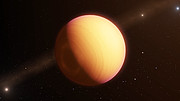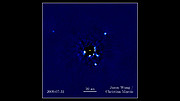GRAVITY instrument breaks new ground in exoplanet imaging
HR 8799 in the constellation Pegasus
Surroundings of the star HR 8799
Aerial view of the VLTI with tunnels superimposed
VLT interferometer principle
Videos
ESOcast 197 Light: GRAVITY uncovers stormy exoplanet skies
Orbital motion of the HR8799 system
Cutting-edge VLTI instrument reveals details of a storm-wracked exoplanet using optical interferometry
The GRAVITY instrument on ESO’s Very
Large Telescope Interferometer (VLTI) has made the first direct
observation of an exoplanet using optical interferometry. This method
revealed a complex exoplanetary atmosphere with clouds of iron and
silicates swirling in a planet-wide storm. The technique presents unique
possibilities for characterising many of the exoplanets known today.
This result was announced today in a letter in the journal Astronomy and Astrophysics by the GRAVITY Collaboration [1], in which they present observations of the exoplanet HR8799e using optical interferometry. The exoplanet was discovered in 2010 orbiting the young main-sequence star HR8799, which lies around 129 light-years from Earth in the constellation of Pegasus.
Today’s result, which reveals new characteristics of
HR8799e, required an instrument with very high resolution and
sensitivity. GRAVITY can use ESO’s VLT’s four unit telescopes to work together to mimic a single larger telescope using a technique known as interferometry [2]. This creates a super-telescope — the VLTI — that collects and precisely disentangles the light from HR8799e’s atmosphere and the light from its parent star [3].
HR8799e is a ‘super-Jupiter’,
a world unlike any found in our Solar System, that is both more massive
and much younger than any planet orbiting the Sun. At only 30 million
years old, this baby exoplanet is young enough to give scientists a
window onto the formation of planets and planetary systems. The
exoplanet is thoroughly inhospitable — leftover energy from its
formation and a powerful greenhouse effect heat HR8799e to a hostile
temperature of roughly 1000 °C.
This is the first time that optical interferometry has been
used to reveal details of an exoplanet, and the new technique furnished
an exquisitely detailed spectrum
of unprecedented quality — ten times more detailed than earlier
observations. The team’s measurements were able to reveal the
composition of HR8799e’s atmosphere — which contained some surprises.
“Our analysis showed that HR8799e has an atmosphere
containing far more carbon monoxide than methane — something not
expected from equilibrium chemistry,” explains team leader
Sylvestre Lacour researcher CNRS at the Observatoire de Paris - PSL and
the Max Planck Institute for Extraterrestrial Physics. “We can best
explain this surprising result with high vertical winds within the
atmosphere preventing the carbon monoxide from reacting with hydrogen to
form methane.”
The team found that the atmosphere also contains clouds of
iron and silicate dust. When combined with the excess of carbon
monoxide, this suggests that HR8799e’s atmosphere is engaged in an
enormous and violent storm.
“Our observations suggest a ball of gas illuminated
from the interior, with rays of warm light swirling through stormy
patches of dark clouds,” elaborates Lacour. “Convection moves
around the clouds of silicate and iron particles, which disaggregate and
rain down into the interior. This paints a picture of a dynamic
atmosphere of a giant exoplanet at birth, undergoing complex physical
and chemical processes.”
This result builds on GRAVITY’s string of impressive discoveries, which have included breakthroughs such as last year’s observation
of gas swirling at 30% of the speed of light just outside the event
horizon of the massive Black Hole in the Galactic Centre. It also adds a new way of observing exoplanets to the already extensive arsenal of methods available to ESO’s telescopes and instruments — paving the way to many more impressive discoveries [4].
Notes
[1] GRAVITY was developed by a collaboration consisting of the Max Planck Institute for Extraterrestrial Physics (Germany), LESIA of Paris Observatory–PSL / CNRS / Sorbonne Université / Univ. Paris Diderot and IPAG of Université Grenoble Alpes / CNRS (France), the Max Planck Institute for Astronomy (Germany), the University of Cologne (Germany), the CENTRA–Centro de Astrofisica e Gravitação (Portugal) and ESO.
[2] Interferometry is a
technique that allows astronomers to create a super-telescope by
combining several smaller telescopes. ESO’s VLTI is an interferometric
telescope created by combining two or more of the Unit Telescopes (UTs)
of the Very Large Telescope or all four of the smaller Auxiliary Telescopes.
While each UT has an impressive 8.2-m primary mirror, combining them
creates a telescope with 25 times more resolving power than a single UT
observing in isolation.
[3] Exoplanets can be observed using many different methods. Some are indirect, such as the radial velocity method used by ESO’s exoplanet-hunting HARPS instrument, which measures the pull a planet’s gravity has on its parent star. Direct methods, like the technique pioneered for this result, involve observing the planet itself instead of its effect on its parent star.
[4] Recent exoplanet discoveries made using ESO telescopes include last year’s successful detection of a super-Earth orbiting Barnard’s Star, the closest single star to our Sun, and ALMA’s discovery of young planets orbiting an infant star, which used another novel technique for planet detection.
More Information
This research was presented in the paper “First direct detection of an exoplanet by optical interferometry” in Astronomy and Astrophysics.
The team was composed of : S. Lacour (LESIA, Observatoire
de Paris - PSL, CNRS, Sorbonne Universités, UPMC Univ. Paris 06, Univ.
Paris Diderot, Meudon, France [LESIA]; Max Planck Institute for
Extraterrestrial Physics, Garching, Germany [MPE]), M. Nowak (LESIA), J.
Wang (Department of Astronomy, California Institute of Technology,
Pasadena, USA), O. Pfuhl (MPE), F. Eisenhauer (MPE), R. Abuter (ESO,
Garching, Germany), A. Amorim (Universidade de Lisboa, Lisbon, Portugal;
CENTRA - Centro de Astrofísica e Gravitação, IST, Universidade de
Lisboa, Lisbon, Portugal), N. Anugu (Faculdade de Engenharia,
Universidade do Porto, Porto, Portugal; School of Physics, Astrophysics
Group, University of Exeter, Exeter, United Kingdom), M. Benisty (Univ.
Grenoble Alpes, CNRS, IPAG, Grenoble, France [IPAG]), J.P. Berger
(IPAG), H. Beust (IPAG), N. Blind (Observatoire de Genève, Université de
Genève, Versoix, Switzerland), M. Bonnefoy (IPAG), H. Bonnet (ESO,
Garching, Germany), P. Bourget (ESO, Santiago, Chile), W. Brandner (Max
Planck Institute for Astronomy, Heidelberg, Germany [MPIA]), A. Buron
(MPE), C. Collin (LESIA), B. Charnay (LESIA), F. Chapron (LESIA) , Y.
Clénet (LESIA), V. Coudé du Foresto (LESIA), P.T. de Zeeuw (MPE;
Sterrewacht Leiden, Leiden University, Leiden, The Netherlands), C. Deen
(MPE), R. Dembet (LESIA), J. Dexter (MPE), G. Duvert (IPAG), A. Eckart
(1st Institute of Physics, University of Cologne, Cologne, Germany; Max
Planck Institute for Radio Astronomy, Bonn, Germany), N.M. Förster
Schreiber (MPE), P. Fédou (LESIA), P. Garcia (Faculdade de Engenharia,
Universidade do Porto, Porto, Portugal; ESO, Santiago, Chile; CENTRA -
Centro de Astrofísica e Gravitação, IST, Universidade de Lisboa, Lisbon,
Portugal), R. Garcia Lopez (Dublin Institute for Advanced Studies,
Dublin, Ireland; MPIA), F. Gao (MPE), E. Gendron (LESIA), R. Genzel
(MPE; Departments of Physics and Astronomy, University of California,
Berkeley, USA), S. Gillessen (MPE), P. Gordo (Universidade de Lisboa,
Lisbon, Portugal; CENTRA - Centro de Astrofísica e Gravitação, IST,
Universidade de Lisboa, Lisbon, Portugal), A. Greenbaum (Department of
Astronomy, University of Michigan, Ann Arbor, USA), M. Habibi (MPE), X.
Haubois (ESO, Santiago, Chile), F. Haußmann (MPE), Th. Henning (MPIA),
S. Hippler (MPIA), M. Horrobin (1st Institute of Physics, University of
Cologne, Cologne, Germany), Z. Hubert (LESIA), A. Jimenez Rosales (MPE),
L. Jocou (IPAG), S. Kendrew (European Space Agency, Space Telescope
Science Institute, Baltimore, USA; MPIA), P. Kervella (LESIA), J. Kolb
(ESO, Santiago, Chile), A.-M. Lagrange (IPAG), V. Lapeyrère (LESIA),
J.-B. Le Bouquin (IPAG), P. Léna (LESIA), M. Lippa (MPE), R. Lenzen
(MPIA), A.-L. Maire (STAR Institute, Université de Liège, Liège,
Belgium; MPIA), P. Mollière (Sterrewacht Leiden, Leiden University,
Leiden, The Netherlands), T. Ott (MPE), T. Paumard (LESIA), K. Perraut
(IPAG), G. Perrin (LESIA), L. Pueyo (Space Telescope Science Institute,
Baltimore, USA), S. Rabien (MPE), A. Ramírez (ESO, Santiago, Chile), C.
Rau (MPE), G. Rodríguez-Coira (LESIA), G. Rousset (LESIA), J.
Sanchez-Bermudez (Instituto de Astronomía, Universidad Nacional Autónoma
de México, Mexico City, Mexico; MPIA), S. Scheithauer (MPIA), N.
Schuhler (ESO, Santiago, Chile), O. Straub (LESIA; MPE), C. Straubmeier
(1st Institute of Physics, University of Cologne, Cologne, Germany), E.
Sturm (MPE), L.J. Tacconi (MPE), F. Vincent (LESIA), E.F. van Dishoeck
(MPE; Sterrewacht Leiden, Leiden University, Leiden, The Netherlands),
S. von Fellenberg (MPE), I. Wank (1st Institute of Physics, University
of Cologne, Cologne, Germany), I. Waisberg (MPE) , F. Widmann (MPE), E.
Wieprecht (MPE), M. Wiest (1st Institute of Physics, University of
Cologne, Cologne, Germany), E. Wiezorrek (MPE), J. Woillez (ESO,
Garching, Germany), S. Yazici (MPE; 1st Institute of Physics, University
of Cologne, Cologne, Germany), D. Ziegler (LESIA), and G. Zins (ESO,
Santiago, Chile).
ESO is the foremost intergovernmental astronomy
organisation in Europe and the world’s most productive ground-based
astronomical observatory by far. It has 16 Member States: Austria,
Belgium, the Czech Republic, Denmark, France, Finland, Germany, Ireland,
Italy, the Netherlands, Poland, Portugal, Spain, Sweden, Switzerland
and the United Kingdom, along with the host state of Chile and with
Australia as a Strategic Partner. ESO carries out an ambitious programme
focused on the design, construction and operation of powerful
ground-based observing facilities enabling astronomers to make important
scientific discoveries. ESO also plays a leading role in promoting and
organising cooperation in astronomical research. ESO operates three
unique world-class observing sites in Chile: La Silla, Paranal and
Chajnantor. At Paranal, ESO operates the Very Large Telescope and its
world-leading Very Large Telescope Interferometer as well as two survey
telescopes, VISTA working in the infrared and the visible-light VLT
Survey Telescope. Also at Paranal ESO will host and operate the
Cherenkov Telescope Array South, the world’s largest and most sensitive
gamma-ray observatory. ESO is also a major partner in two facilities on
Chajnantor, APEX and ALMA, the largest astronomical project in
existence. And on Cerro Armazones, close to Paranal, ESO is building the
39-metre Extremely Large Telescope, the ELT, which will become “the
world’s biggest eye on the sky”.
Links
Links
Contacts
Sylvestre Lacour
CNRS/LESIA, Observatoire de Paris - PSL
5 place Jules Janssen, Meudon, France
Tel: +33 6 81 92 53 89
Email: Sylvestre.lacour@observatoiredeparis.psl.eu
Mathias Nowak
CNRS/LESIA, Observatoire de Paris - PSL
5 place Jules Janssen, Meudon, France
Tel: +33 1 45 07 76 70
Cell: +33 6 76 02 14 48
Email: Mathias.nowak@observatoiredeparis.psl.eu
Dr. Paul Mollière
Sterrewacht Leiden, Huygens Laboratory
Leiden, The Netherlands
Tel: +31 64 2729185
Email: molliere@strw.leidenuniv.nl
Calum Turner
ESO Public Information Officer
Garching bei München, Germany
Tel: +49 89 3200 6670
Email: pio@eso.org
Source: ESO/News






